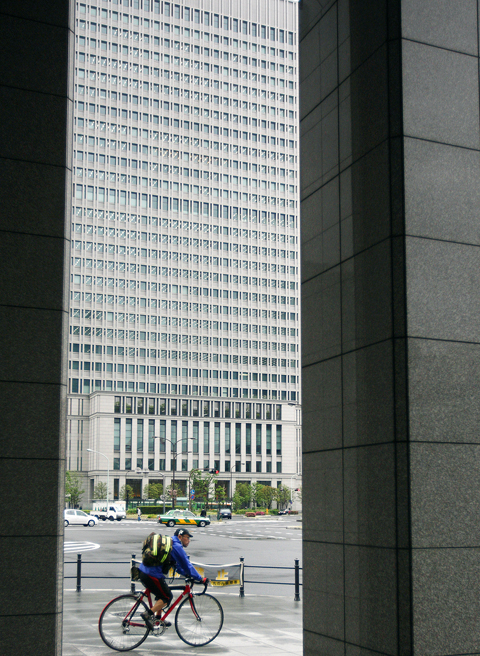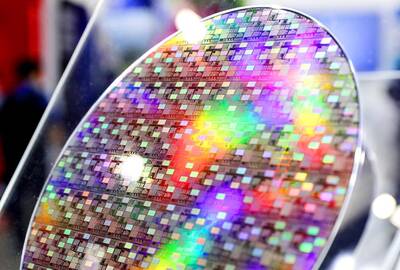Hitachi Ltd yesterday posted a group net loss of ¥82.67 billion (US$868 million) for the second quarter, dragged deep into the red by persistent weak demand for its electronics products.
Hitachi, which produces everything from home appliances to medical equipment to nuclear reactors, had net profit of ¥31.6 billion during the same period a year earlier.
The company made headlines three months ago for booking a fiscal year loss of ¥787.3 billion — the biggest ever annual loss by a Japanese manufacturer.

PHOTO: BLOOMBERG
The company also announced plans to take over five publicly traded units through a tender offer.
The Tokyo-based company will acquire the outstanding shares of Hitachi Maxwell Ltd, Hitachi Information Systems Ltd, Hitachi Systems & Services Ltd, Hitachi Software Engineering Co and Hitachi Plant Technologies Ltd.
Analysts said the takeovers would do little to change their bearish opinion on the company’s outlook.
“The market consensus is that Hitachi needs to boost its capital, but there are no signs of measures to sell off non-core businesses that could provide a cash inflow, and ... its funding needs are set to swell,” Hideyuki Maekawa, an analyst at Credit Suisse, wrote in a note to clients.
Credit Suisse has pegged Hitachi shares with its lowest “underperform” rating.
Hitachi’s revenue for the three months through June 30 retreated 26 percent to ¥1.89 trillion, the company said.
It booked of ¥50.6 billion in operating losses — a measure of core business — compared with ¥77.7 billion operating profit last year.
For the full fiscal year through next March, Hitachi continues to expect a ¥270 billion net loss on sales of of ¥8.9 trillion.
Separately, Canon Inc said yesterday its net profit tumbled 84.5 percent year-on-year in the first half of the year, hit by sluggish sales of compact digital cameras and other electronics.
The yen’s strength against other currencies also ate into profits at Canon, which relies heavily on consumers in overseas markets for sales.
The photographic and office equipment maker said net profit plunged to of ¥33.35 billion in the six months through last month — the first half of its business year — from 214.49 billion in the same period last year.
Operating profit slumped 80.4 percent to ¥64.94 billion as revenue decreased 29.9 percent to ¥1.48 trillion, the company said in a statement.
Canon has enjoyed strong sales of high-end digital single-lens reflex (SLR) cameras in recent years, but it has not been immune to the global economic downturn, which has battered Japanese electronics makers.
For the whole of the year, Canon left its net profit forecast unchanged at ¥110 billion.
It raised its operating profit projection to ¥190 billion from ¥180 billion, but trimmed its revenue goal to ¥3.32 trillion from ¥3.33 trillion.
“Demand for inkjet printers and compact digital cameras is expected to remain stagnant for the time being due to the drop in consumer sentiment resulting from the weak economy, whereas demand for digital SLR cameras is expected to remain strong,” the statement said.

WAITING GAME: The US has so far only offered a ‘best rate tariff,’ which officials assume is about 15 percent, the same as Japan, a person familiar with the matter said Taiwan and the US have completed “technical consultations” regarding tariffs and a finalized rate is expected to be released soon, Executive Yuan spokeswoman Michelle Lee (李慧芝) told a news conference yesterday, as a 90-day pause on US President Donald Trump’s “reciprocal” tariffs is set to expire today. The two countries have reached a “certain degree of consensus” on issues such as tariffs, nontariff trade barriers, trade facilitation, supply chain resilience and economic security, Lee said. They also discussed opportunities for cooperation, investment and procurement, she said. A joint statement is still being negotiated and would be released once the US government has made

NEW GEAR: On top of the new Tien Kung IV air defense missiles, the military is expected to place orders for a new combat vehicle next year for delivery in 2028 Mass production of Tien Kung IV (Sky Bow IV) missiles is expected to start next year, with plans to order 122 pods, the Ministry of National Defense’s (MND) latest list of regulated military material showed. The document said that the armed forces would obtain 46 pods of the air defense missiles next year and 76 pods the year after that. The Tien Kung IV is designed to intercept cruise missiles and ballistic missiles to an altitude of 70km, compared with the 60km maximum altitude achieved by the Missile Segment Enhancement variant of PAC-3 systems. A defense source said yesterday that the number of

‘CRUDE’: The potential countermeasure is in response to South Africa renaming Taiwan’s representative offices and the insistence that it move out of Pretoria Taiwan is considering banning exports of semiconductors to South Africa after the latter unilaterally downgraded and changed the names of Taiwan’s two representative offices, the Ministry of Foreign Affairs (MOFA) said yesterday. On Monday last week, the South African Department of International Relations and Cooperation unilaterally released a statement saying that, as of April 1, the Taipei Liaison Offices in Pretoria and Cape Town had been renamed the “Taipei Commercial Office in Johannesburg” and the “Taipei Commercial Office in Cape Town.” Citing UN General Assembly Resolution 2758, it said that South Africa “recognizes the People’s Republic of China (PRC) as the sole

Taiwanese exports to the US are to be subject to a 20 percent tariff starting on Thursday next week, according to an executive order signed by US President Donald Trump yesterday. The 20 percent levy was the same as the tariffs imposed on Vietnam, Sri Lanka and Bangladesh by Trump. It was higher than the tariffs imposed on Japan, South Korea and the EU (15 percent), as well as those on the Philippines (19 percent). A Taiwan official with knowledge of the matter said it is a "phased" tariff rate, and negotiations would continue. "Once negotiations conclude, Taiwan will obtain a better